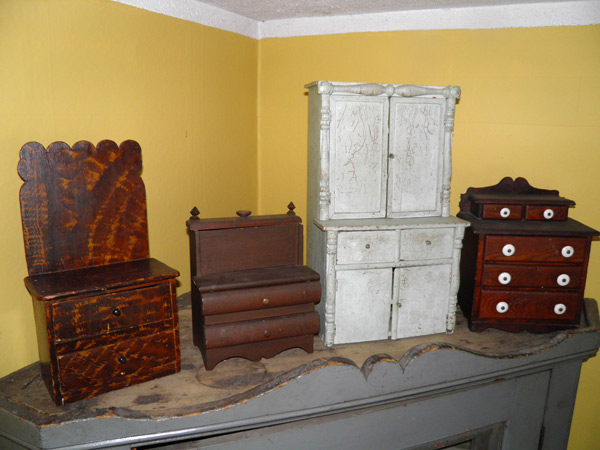By Shaun Markey –
Antique collectors always have ways of adding more items to their collections, even when they run out of space. What’s a collector of antique furniture to do when he or she has filled all available space? Simple. Start collecting small-scale antique furniture!
Little antique furniture is a fascinating area of collecting. In fact, pint-sized furniture pieces and other antique accessories are eagerly sought after by collectors and the price points for these pipsqueaks can often reach lofty heights.
As I have pointed out in a previous column, the value of an antique is directly related to some key factors. Age, form, colour, condition and origin are all important.
When I approach any antique object, my mind automatically starts processing the piece through a mental checklist. I’m considering the age of the piece, the form used in its construction, type of wood, the condition of the piece and the colour or finish. If an antique scores high marks on all of these categories I might add it to my collection.
Despite their size, all of these factors come into play with small-scale furniture. That’s why collectors are keen on them. The process of seeking them out, evaluating and acquiring them is exactly the same as the process one goes through for their full-scale cousins. You could easily make the case that it’s even more enjoyable because these small items have a charm about them that regular antique furniture does not.
Little furniture can be functional. Collectors use them to store precious items like jewelry. It’s also fun to display them beside life-size furniture. They can quickly become the highlight of any conversation among collectors. Even non-collectors recognize the charm and attraction of small-scale antique furniture.

On occasion, makers will sign a drawer bottom with their name. Discovering a penciled note written 100 years ago on the back of a little antique dresser is quite a moving experience. It’s touching to imagine the individual who made the item and signed it so many years ago.
Even within this category, there are a seemingly endless variety of shapes and sizes. It includes everything from miniature furniture, the really small items, to pieces made for children to use, which are roughly half to two thirds the size of pieces intended for use by adults. Much of this little furniture was made as toys, keepsakes or gifts.
In particular, collectors are very interested in what are known as “salesman samples.” These are small versions of furniture made exactly like their full-size counterparts. They have all the same features including moldings, panels, feet, splashboards, drawers etc. The most common are chests of drawers, dish dressers and drop front desks. There’s quite a variety of small furniture made to store thread, buttons and needles for sewing.

Since furniture makers in the old days did not have show rooms, travelling salesmen would carry these samples with them to use as props during their meetings with potential customers. You see these salesman samples in other products as well, like cast iron stoves and certain types of machinery.
The search for small-scale furniture takes collectors to all the usual places. They know their next piece might be found at a flea market, in a shop, at an auction, church rummage sale or a garage sale.
These little pieces of furniture, because of their size, have survived quite well over the years. They are often tucked away in closets, in workbenches or inside of larger pieces of furniture where they can remain for many years until the owner consigns them to a sale and some sharp-eyed collector spies them. Compare that to the fate of full-sized furniture, which is often relegated to a basement or garage where they can degrade quite quickly because of rough use, dampness and neglect.
The values of these little antiques can run the gamut from a few dollars to several thousand. If you find one a hundred years old or more in original paint with good form and in great condition get your cheque book out and be prepared for at least a couple of zeros past the first number. I have seen little pieces of furniture at antique shows with asking prices in excess of $1,500. Dealers know these collectibles are highly desirable and price them accordingly.
One of the advantages of collecting small antiques is that you can simply tuck them under your arm. Gone are the days of trying to squeeze a set of chairs into the back seat of your car or struggling to get that drop leaf table into the trunk. You’ll never again have to cast longing looks at your neighbour’s half ton truck!
As a general rule of thumb, “small” is always good in antiques. That is true of small-scale furniture. Often overlooked, these little creations continue to create joy and fascination for all who collect them.
Shaun Markey has been a collector of Canadian antiques and folk art for over 30 years. He is a long time resident of Westboro and the author of Folk Art in the Attic, a memoir of his antique collecting experiences. He also writes for some of North America’s leading antique publications including the Maine Antique Digest, Canadian Antique and Vintage, New England Antiques Journal and The WayBack Times.
